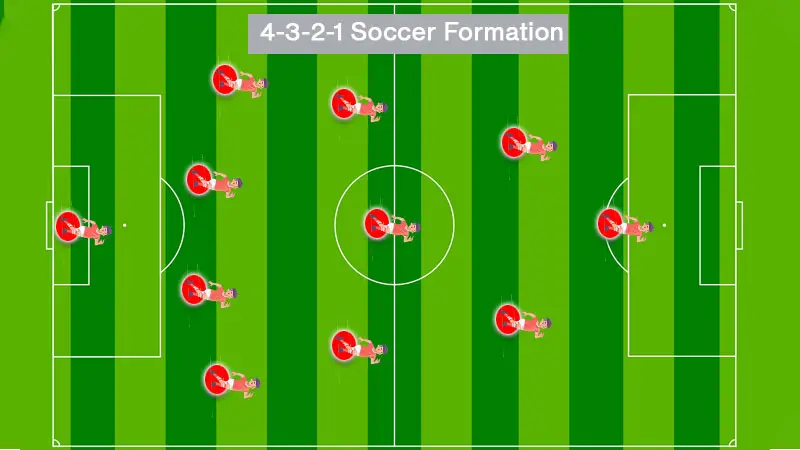The 4-3-2-1 soccer formation, often dubbed the “Christmas Tree,” offers a unique blend of defensive solidity and attacking flair.
This tactical setup, popularized by some of the world’s top teams, balances the field with four defenders, three midfielders, two attacking midfielders, and a lone striker. It’s designed to provide a robust defense while maintaining creative options upfront.
Teams adopting the 4-3-2-1 formation benefit from its flexibility and adaptability. The three central midfielders can control the game’s tempo, while the two advanced playmakers support the striker, creating numerous scoring opportunities.
This formation’s structure allows teams to transition smoothly between defense and attack, making it a favorite among coaches seeking a balanced yet dynamic approach.
The 4-3-2-1 Formation Explained
The 4-3-2-1 soccer formation, often termed the “Christmas Tree,” offers unique tactical advantages. This setup balances defensive strength and attacking creativity, leveraging its structured yet adaptable shape.
Origins and Evolution
The 4-3-2-1 formation originated in the late 1990s. AC Milan, managed by Carlo Ancelotti, popularized this setup. It evolved from the need to combine defensive stability with creative offensive play.
As various coaches adopted this formation, it saw tweaks and refinements to suit different playing styles and tactical requirements.
- Defensive Solidity: The formation includes four defenders who maintain a compact shape, making it difficult for the opposition to penetrate.
- Midfield Control: Three central midfielders, often with diverse roles such as a defensive midfielder, a box-to-box player, and a deep-lying playmaker, control the game’s tempo and provide balance.
- Attacking Flexibility: Two attacking midfielders support the lone striker, creating multiple attacking options. These players often interchange positions, adding unpredictability.
- Smooth Transitions: The 4-3-2-1 allows seamless transitions between defense and attack due to its balanced structure, making it highly effective in counter-attacks.
The 4-3-2-1 formation excels in its balance, providing teams with both defensive resilience and offensive versatility.
Strategic Depth of the 4-3-2-1 Formation
The 4-3-2-1 formation offers profound strategic depth, making it effective across various phases of play. Its structure facilitates both offensive maneuvers and defensive solidity.
Offensive Strategies
In attack, the 4-3-2-1 formation unleashes creativity and penetration. The lone striker, flanked by two attacking midfielders, generates goal-scoring opportunities.
These midfielders often drop back to link up with the central midfielders, creating a diamond shape that enhances ball retention and fluidity in the final third.
Creating Overloads: Attacking midfielders and full-backs work in unison to create numerical advantages on the flanks. This ensures wingers can exploit space behind the opposition’s defense.
Positional Rotation: Constant movement and positional rotation among the attacking trio confuse defenders, making it harder to mark players effectively.
Defensive Responsibilities
Defensively, the 4-3-2-1 formation excels in maintaining shape and compactness. The four defenders provide a solid backline, while the three central midfielders offer a defensive shield.
Midfield Press: Central midfielders press high to regain possession quickly. Their positioning disrupts the opposition’s build-up play.
Narrow Defensive Shape: The narrow setup limits space in crucial areas, forcing opponents to play wide and reducing the risk of central penetrations.
Support from Attackers: Attacking midfielders drop back to form a second line of defense. This helps to close down spaces and support the central midfield, ensuring that the team maintains a strong defensive block.
This strategic depth makes the 4-3-2-1 formation a versatile and dynamic choice for both offensive and defensive scenarios.
Player Roles in the 4-3-2-1 Formation
The 4-3-2-1 formation relies on well-defined roles for each player, ensuring a balanced approach between defense and attack.
Goalkeeper and Defense
The goalkeeper acts as the last line of defense, commanding the penalty area and distributing the ball effectively for counter-attacks. The four defenders consist of two center-backs and two full-backs.
Center-backs focus on stopping opposing forwards and winning aerial duels, while full-backs provide width by advancing up the pitch and supporting attacks.
Midfield Dynamics
The midfield trio in the 4-3-2-1 formation have critical responsibilities. The central defensive midfielder (CDM) acts as a shield for the defense, breaking up opposition plays and initiating attacks.
The other two midfielders, often more box-to-box, support both defense and attack, providing passing options and aiding in ball retention. Their versatility is key for maintaining balance and dictating the tempo.
Attackers’ Role
In this formation, two attacking midfielders support the lone striker. These playmakers create chances through dribbling, passing, and positioning. They exploit spaces between the opposition’s defense and midfield.
The lone striker focuses on converting chances, holding up the ball, and linking up with the attacking midfielders to penetrate the defense.
Each role in the 4-3-2-1 formation is crucial for a cohesive strategy, enabling teams to seamlessly transition between defensive solidity and attacking flair.
Advantages of the 4-3-2-1 Formation
The 4-3-2-1 formation provides defensive solidity, strong midfield control, and dynamic attacking options, making it effective for both maintaining possession and launching counter-attacks.
Defensive Stability
One key advantage of the 4-3-2-1 formation is defensive stability. With four defenders at the back, it offers a solid line of defense. The three central midfielders provide additional support, reducing space for the opposition to exploit.
Having two players in front of the lone striker also helps in dropping back to support the midfield when out of possession.
Midfield Control
Control of the midfield is another significant benefit. The trio of central midfielders ensures dominance in this critical part of the pitch. They can maintain possession, dictate the tempo of the game, and break up opposition attacks effectively.
This control is essential for transitioning swiftly from defense to attack.
Attacking Flexibility
The 4-3-2-1 formation provides attacking flexibility. The two attacking midfielders behind the lone striker can create numerous scoring opportunities.
They have the freedom to roam, combine, and support the striker, making the attack less predictable and more dynamic. This increases the chances of breaking down rigid defenses.
Effective Counter-Attacks
Effective counter-attacking is a strength of this setup. With quick transitions facilitated by the central midfielders and pacey attacking midfielders, teams can catch opponents off guard.
The lone striker, supported by the two attacking midfielders, often finds himself in beneficial positions during counter-attacks.
Positional Versatility
Players enjoy positional versatility in the 4-3-2-1 formation. The attacking midfielders can operate as wingers or secondary strikers when needed. This adaptability makes it easier to adjust tactics during the game according to the match situation, providing a strategic advantage.
Cohesive Team Play
Cohesive team play thrives in this formation. Each player’s role is well-defined, promoting a balanced team structure. The understanding between defenders, midfielders, and attackers ensures smooth transitions and effective execution of tactics.
This unity is crucial for maximizing the formation’s potential.
Challenges of the 4-3-2-1 Formation
Limited Width: Teams using this formation often struggle to maintain width on the field. This can allow opponents to exploit flanks and create scoring opportunities. Without natural wingers, full-backs must frequently push forward, potentially leaving gaps in defense.
Central Overload
With three central midfielders and two attacking mids, the 4-3-2-1 can lead to congestion in the middle. This can reduce passing options and make it easier for opponents to press and regain possession.
High Defensive Demands
Full-backs need to support both defense and attack, increasing their workload. They must cover extensive ground which can lead to fatigue and late-match vulnerabilities.
Lone Striker Isolation
A single forward can become isolated if the midfielders fail to support consistently. This can reduce goal-scoring chances and require the striker to hold up the ball more often.
Versatility Requirement
Players must adapt to different roles within the formation. A lack of versatile players makes it harder to execute the tactics efficiently.
Counter-attack Susceptibility
With full-backs advancing and central areas crowded, quick turnovers can leave the defense exposed to counter-attacks. Opponents can exploit the spaces left behind by advanced players.
Notable Teams and Managers Using the 4-3-2-1
The 4-3-2-1 formation has seen some notable success under various teams and managers. Here’s a closer look at key instances.
Historical Success Stories
AC Milan, under Carlo Ancelotti, dominated European soccer with the 4-3-2-1 formation, winning two UEFA Champions League titles (2003 and 2007) by maximizing the talents of legends like Andrea Pirlo and Kaka.
Real Madrid, managed by Fabio Capello, secured the 2006-2007 La Liga title using the same formation, focusing on pragmatism and defense with key players such as Ruud van Nistelrooy and Mahamadou Diarra.
Modern Implementations
Pep Guardiola’s Manchester City sometimes uses the 4-3-2-1 formation to enhance midfield control and pressing, demonstrating Guardiola’s tactical skill and the versatility of players like Kevin De Bruyne and Bernardo Silva.
Similarly, Jose Mourinho used this formation at Chelsea from 2004 to 2007, focusing on strong defense and quick counter-attacks, which led to Chelsea winning consecutive Premier League titles in 2005 and 2006, with key contributions from Frank Lampard and Claude Makelele.
Frequently Asked Questions
What challenges does the 4-3-2-1 formation present?
The main challenge of the 4-3-2-1 formation is the need for player adaptability and cohesive teamwork. Players must maintain defensive solidity while also supporting offensive plays, which requires excellent tactical awareness and execution.
Which notable managers have successfully used the 4-3-2-1 formation?
Historical successes of the 4-3-2-1 formation include Carlo Ancelotti’s AC Milan and Fabio Capello’s Real Madrid. More recently, Pep Guardiola at Manchester City and Jose Mourinho at Chelsea have also optimized this formation to achieve significant victories.
How does player adaptability affect the success of the 4-3-2-1 formation?
Player adaptability is crucial for the success of the 4-3-2-1 formation. Players need to effectively switch between defensive and offensive roles, ensuring a balanced and cohesive team performance.
What are the key traits of a good team for the 4-3-2-1 formation?
A team suited for the 4-3-2-1 formation should have players with strong defensive skills, creativity in midfield, and a versatile forward. The team must exhibit high tactical discipline and the ability to transition smoothly between defense and attack.
How did Pep Guardiola and Jose Mourinho optimize the 4-3-2-1 formation?
Pep Guardiola and Jose Mourinho optimized the 4-3-2-1 formation by emphasizing player roles and strategic positioning. Guardiola focused on fluid passing and positional play at Manchester City, while Mourinho utilized solid defensive structures and swift counter-attacks at Chelsea.
Conclusion
The 4-3-2-1 formation, or “Christmas Tree,” remains a powerful tactical option in modern soccer. Its blend of defensive solidity and offensive versatility makes it a favorite among top managers.
Historical successes and contemporary applications by renowned coaches illustrate its enduring effectiveness. Mastery of this formation demands player adaptability and precise strategic execution.
When implemented correctly it can lead to significant victories and memorable performances on the field. One key advantage is its ability to overcrowd the midfield, disrupting the opponent’s play and gaining control of the game’s tempo.
Additionally, the inverted pyramid shape allows for fluid transitions between defense and attack. The wingbacks also play a crucial role, providing width and support while maintaining defensive integrity.
With the correct personnel and training, the 4-3-2-1 formation can outmaneuver most systems, making it an invaluable asset in a team’s tactical arsenal.








Brice Petersen